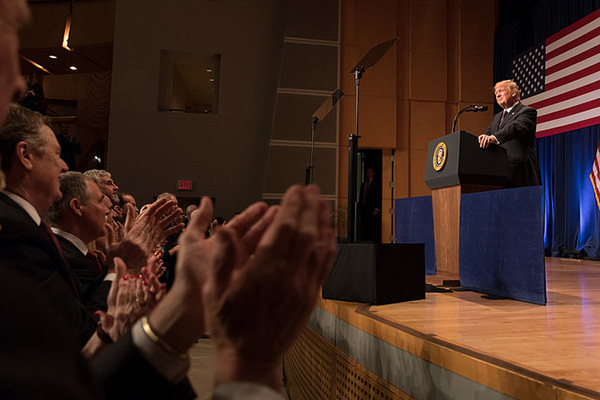Original version in Spanish: La Estrategia de Seguridad Nacional de la Administración Trump
Summary
At the end of 2017 the US published a new National Security Strategy (NSS), replacing the previous NSS of 2015 in record time.
This working paper analyses the new NSS. The US strategy now perceives a hyper-competitive world on the horizon, very different from that seen in decades past. The NSS argues that the US should be prepared to compete in the best of conditions, beginning with its domestic scenario. This paper focuses on the four pillars (areas of national interest) identified by the new NSS: (1) to protect the territory, sovereignty and the ‘American way of life’ of the US; (2) to promote the country’s prosperity; (3) to preserve peace through strength; and (4) to promote US influence in the world.
Th structure of this working paper is based on these same four pillars, but it also analyses the three broad categories of threats facing the US –at once military, political and increasingly economic– in the context of this geopolitical competition. China and Russia –characterised as revisionist powers that challenge the power, influence and interests of the US by attempting to erode its prosperity and security– comprise the first group. In the second group are the ‘rogue regimes’ –North Korea and Iran– that pursue the possession of weapons of mass destruction, support terrorism and destabilise. Finally, there is another group that includes transnational and other criminal threats, along with terrorism. Significantly, after more than a decade and a half, the fight against terrorism is no longer the top priority of US national security.
The new NSS aspires to move beyond ‘leading from behind’ to a deeper engagement with this increasingly tough global competition. The US will strive to regain its leadership in new technologies and innovation and to adapt to the new competition in cyberspace and outer space. This will be done while prioritising US interests under the heading of an ‘America First’ foreign policy and placing more emphasis on competition than on cooperation.
Introduction
‘America first’, economic security, nuclear, space and cyberspace capacities in a return to geopolitical competition between great powers
The new National Security Strategy of the US is the latest of a series of documents devised by successive US Administrations that integrate foreign policy, national defence, international economic relations and development aid policy. This type of document is typically supposed to be, at least in theory, the culmination of a complex bureaucratic and inter-agency consultative process in which each participating entity establishes a series of objectives and priorities to contribute to national security. Furthermore, it also typically defines a common vocabulary for all of those charged with executing such a strategy, designing and pursuing specific sub-strategies and action plans, in turn linked to concrete budget appropriations and therefore based upon actually available resources. This is to say that everything that follows from the formulation of the strategy is what actually lends it coherence and significance.
Over time these NSS documents have become increasingly less relevant as they have become less precise, cliché ridden and overly ambitious. The strategies have tended to identify too many priorities (and therefore fix no clear priorities) without recognising any resource constraint (ie, the budget that the federal government has available to implement the strategic agenda). In this respect, the new NSS falls into similar traps to those of the past: it fails in its attempt to balance means with ends, overemphasising the latter at the expense of the former. Indeed, the Trump Administration submitted its budget requests to Congress months before it had finalised the new NSS. The strategic objectives that are established in any NSS lack real meaning until they are linked to, and supported by, the required military, economic and diplomatic means. Planning should therefore proceed in parallel with a realistic evaluation of capacities.
As with its predecessors, the objectives set forth in the Trump Administration’s new NSS do not appear to acknowledge any specific material or political limitations. This also occurred under George W. Bush when the central objective of his 2006 NSS was defined as ‘ending tyranny in the world’. On the other hand, Barack Obama established eight priority challenges, ranging from climate change and infectious diseases to the proliferation of weapons of mass destruction and failed states.
Not since 2002 –when George W. Bush’s doctrine of preventive war made its appearance– has so much attention been paid to the publication of the NSS document. Growing doubts over the role of the US in the world –generated by a President who presents himself as ‘disruptive’ in the face of the traditional modes of approaching national security– has raised much interest. One should add, however, that the National Security Council of the US has tried to demonstrate a certain degree of coherence on international political issues, particularly since the arrival of the new National Security Advisor, H.R. McMaster, and in spite of the contradictions of US foreign policy during the Administration’s first year.
The new NSS was something of a surprise. On the one hand, it is one of the longest NSS document in US history –nearly double the length of the 2015 version–. It was also published before the Administration’s first year had ended –always desirable but usually not possible given the difficulties inherent to its creation–. However, despite the credentials of H.R. McMaster, Dina Powell, Nadia Schadlow and Seth Center, doubts have emerged as to how much inter-agency coordination took place during the NSS’s preparation (given the amount of time typically involved in the past, but also due to the complexity of the current international scenario). But these are not the only doubts. One of the principal problems facing the team which devised the strategy was that it had too little material to work on: there were no previous documents or keynote addresses by Trump on national security. Furthermore, the presidential transition was chaotic and in Trump’s inaugural address he offered an overly dark picture of ‘America First’. The subsequent departure of his first NSC advisor, Michael Flynn, and other changes at the National Security Council, left the NSC without a real team until March 2017. Nor should we forget the struggles between those in Trump’s government who have been pushing his most radical impulses (ie, Steve Bannon, Sebastian Gorka and Stephen Miller) and those who are working to facilitate more traditional behaviour dynamics (ie, Jim Matthis, John Kelly, Rex Tillerson and H.R. McMaster).
The presentation of the new NSS was also unusual. It was publicly made by the President himself (something which is not normally done). For some reason, Trump wanted to take advantage of the opportunity to make an important policy address, and it was widely expected to be in line with the new strategy. However, it turned out to be more of a campaign speech in which Trump laid out a list of the achievements of his first year as President and another of criticisms of the previous Administration. The disconnect between what Trump actually said and what is contained in the new NSS testify without much doubt to the problems facing his advisors in constructing an intellectual framework for Trump’s ‘America First’ instinct and transforming it into a foreign policy doctrine. His words for China and Russia were notably soft. Although they represent potential rivals, Trump affirmed that he would seek opportunities for collaborating with them, and he even thanked Vladimir Putin for some less than significant gesture. Nevertheless, the formal NSS document is much tougher with respect to these countries, claiming that their objective is to transform the world in a way that opposes the values and interests of the US (NSS, 2017, p. 25).
There are also numerous contradictions between what Trump has said and affirmed both before and since moving into the White House, on the one hand, and the new NSS on the other. The President has called US ‘exceptionalism’ dangerous, while the new NSS affirms that US principles are ‘the lasting force for good in the world’ (p. 1). There are also doubts as to the possible common ground for ‘sharing values and visions’ through collaboration (p. 48), considering the odd transnational vision that Trump has of foreign policy. And if diplomats are ‘indispensable for identifying and implementing solutions to conflicts in unstable regions of the world’ (p. 33), the question arises as to why Trump has tried to gut the State Department. Even more significant: the NSS faces the difficult task of mapping out a strategic path for an impulsive decision-maker. Many of the most important decisions –from the withdrawal from the Trans-Pacific Partnership (TPP) and the Paris Agreement on Climate Change, to the non-certification of the Iran deal and the recognition of Jerusalem as the capital of Israel– have not been made as the result of a studied evaluation of options. Everything seems to indicate that there is a greater likelihood of Trump choosing the short-run perspective and pursue tactical victories, as opposed to any policy based on long-term priorities, as the NSS attempts to articulate.
In the end, the new NSS is an amalgam of traditional US national security culture with many purely Republican Party concepts, but it also includes angles which are uniquely Trump.
This is clear from the emphasis on China, Russia, Iran and North Korea, and on transnational threats like terrorism, which inevitably recall earlier US national security strategies. The NSS also maintains the perennial reference to the traditional US leadership role in the world –the notes are different this time around, but the song is the same– and the standing commitment to prevent global disorder which would involve some cost to its interests and values. It also breaks down the world into regions, as in past strategy documents. The emphasis on the economic strength of the country reappears, along with US competitiveness and resilience –all elements contained in Obama’s NSS from 2015–. Up to this point, the components of the national security strategy show a certain continuity that the US has maintained over the past decades. The emphasis on anti-missile defence, nuclear weapons and certain economic issues, like tax reform and deregulation is new but all these issues form part of the mainstream Republican platform. However, the focus on border security, immigration limits and trade policy, along with the absence of any concern for climate change and the ‘America First’ refrain are the clearest new ‘Trumpian’ elements of national security strategy.
Carlota García Encina
Analyst, Elcano Royal Institute | @EncinaCharlie



